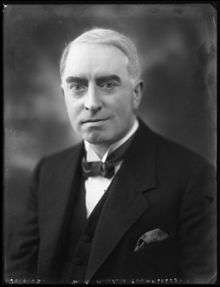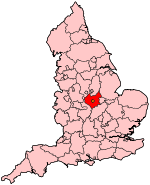Leicester South is a constituency[n 1] represented in the House of Commons of the UK Parliament since 2011 by Jon Ashworth of the Labour Party.[n 2]
Boundaries
When originally created in 1918, the South division of the Parliamentary Borough of Leicester was defined as including the municipal wards of Aylestone, Castle, Charnwood, De Montfort, Knighton, Martin's, and Wycliffe.[2]
The initial report of the Boundary Commission for England dated October 1947 and published in December 1947 recommended that Leicester retain three seats, including a revised Leicester South constituency consisting of the wards of Aylestone, De Montfort, Knighton, North Braunstone and Spinney Hill, giving an electorate of 67,574 as of the review date of 15 October 1946.[3] When the Representation of the People Bill enacting the Commission's recommendations was debated in the House of Commons, the Government brought forward amendments at Committee stage on 24 March 1948 to allow 17 more constituencies in England. Home Secretary James Chuter Ede announced that the Boundary Commission would be invited to consider an additional constituency to each of nine Cities, including Leicester.[4] The Government issued a White Paper proposing the new boundaries which created new borough constituencies of Leicester South East and Leicester South West in place of Leicester South. The Boundary Commission recommended no alteration to the proposals,[5] and the revised constituencies were therefore enacted.
In 1969 the Second Periodical Report of the Parliamentary Boundary Commission for England reduced Leicester from four seats to three, and recreated Leicester South as a borough constituency consisting of the Aylestone, Castle, De Montfort, Knighton, Spinney Hill and Wycliffe wards of Leicester.[6]
Minor boundary changes were made as a result of the Third Periodical Report of the Boundary Commission in 1983. Ward boundaries having changed, the constituency was defined as including the Aylestone, Castle, Crown Hills, East Knighton, Eyres Monsell, Saffron, Spinney Hill, Stoneygate, West Knighton and Wycliffe wards. The new constituency took in about 3,000 voters who were previously in other Leicester seats.[7] No changes were made in the Fourth Periodical Report of the Boundary Commission in 1995,[8] and in the Fifth Periodical Report of the Boundary Commission in 2007, the constituency had only minor changes with 73 voters being added from Leicester West.[9]
Presently the seat is centred on the southern part of Leicester covering leafy suburbs such as Stoneygate and Knighton, as well as inner city areas with a strong Asian community and deprived outer estates such as Saffron and Eyres Monsell. The constituency encompasses the council wards of Spinney Hills, Stoneygate, Knighton, Leicester, Freemen, Aylestone, Eyres Monsell and virtually all of Castle. Another demographic feature is the presence of a large number of students studying at the University of Leicester and De Montfort University, which are both situated in the constituency.
Constituency profile
Leicester South is a varied constituency. It contains some of the most pleasant and affluent areas of Leicester such as Stoneygate, Knighton and Aylestone, as well as more deprived areas such as Saffron and Eyres Monsell. The centre of Leicester, also within the constituency, is more ethnically diverse than the southern part of the area. The seat also contains HMP Leicester and both of Leicester's universities.[10]
This was once a Conservative vs. Labour marginal seat and was held by the Conservatives between 1983 and 1987. It moved strongly towards Labour through the 1990s and was considered a safe Labour seat until the death of Jim Marshall in 2004 . The subsequent by-election was fought under the shadow of the Iraq war and won by the Liberal Democrats from third place, making Parmjit Singh Gill, at the time, the only Liberal Democrat MP from an ethnic minority. He held the seat for a year before being defeated by Labour candidate Sir Peter Soulsby at the 2005 general election. Soulsby subsequently resigned to become elected Mayor of Leicester in 2011, giving Leicester South its second by-election in the space of seven years; the second by-election was safely held by Labour.[10]
History
The constituency was first created in 1918, abolished in 1950, and reconstituted in 1974.
Leicester South has over the past few decades seen demographic and economic changes which have altered the balance of the constituency. The seat saw close contests between Conservative and Labour candidates in the 1980s, with Labour MP Jim Marshall losing the seat by just 7 votes to the Conservatives in the 1983 general election but regaining it in 1987. In subsequent elections a general trend indicates a Labour majority has accumulated that since 1987 it has become more of a safe seat however it has not sent all MPs since.
Marshall died in 2004 and the resulting by-election was fiercely contested. Along with a by-election in Birmingham Hodge Hill held on the same day, the Liberal Democrat candidates hoped to build on their previous by-election gain at Brent East, as well all having additional competition, in an anti-Iraq War vote, from RESPECT The Unity Coalition. The seat was won by the Liberal Democrat Parmjit Singh Gill with a majority of 1,654.
Sir Peter Soulsby, who had been the unsuccessful Labour candidate at the 2004 by-election, won the seat at the 2005 election and was re-elected in 2010. Sir Peter resigned to fight the election for the new position of Mayor of Leicester in 2011, triggering a by-election on 5 May 2011, coinciding with the referendum on the voting system.[11] Jon Ashworth was elected as his successor, holding the seat for the Labour Party.
Members of Parliament
MPs 1918–1950
MPs since 1974
Elections
Elections in the 2010s
Elections in the 2000s
Elections in the 1990s
Elections in the 1980s
Elections in the 1970s
Elections in the 1940s
Elections in the 1930s
Elections in the 1920s

Henry Purchase
Elections in the 1910s
- coalition coupon
See also
Notes and references
- Notes
- ↑ A borough constituency (for the purposes of election expenses and type of returning officer)
- ↑ As with all constituencies, the constituency elects one Member of Parliament (MP) by the first past the post system of election at least every five years.
- References
- ↑ "Electorate Figures – Boundary Commission for England". 2011 Electorate Figures. Boundary Commission for England. 4 March 2011. Retrieved 13 March 2011.
- ↑ "88. Parliamentary Borough of Leicester" in "Report of the Boundary Commission (England and Wales)", Cd. 8757, vol III.
- ↑ "Initial Report", Boundary Commission for England, Cmd. 7260, p. 30-1.
- ↑ "All-Night Debate on New Constituencies", The Times, 25 March 1948, p. 4.
- ↑ "Report of Boundary Commissioners for England on Representations relating to certain proposed new Constituencies", Cmd. 7400, p. 5.
- ↑ F. W. S. Craig, "Boundaries of Parliamentary Constituencies 1885–1972", Political Reference Publications, Chichester, 1972, p. 138.
- ↑ "The BBC/ITN Guide to the New Parliamentary Constituencies", Parliamentary Research Services, Chichester, 1983, p. 89.
- ↑ "Media Guide to the New Parliamentary Constituencies", BBC/ITN/PA News/Sky (Local Government Chronicle Elections Centre), 1995, p. 109.
- ↑ "Media Guide to the New Parliamentary Constituencies (Fifth Periodical Review)", BBC/ITN/PA News/Sky (Local Government Chronicle Elections Centre), 2007, p. 108.
- 1 2 http://ukpollingreport.co.uk/2015guide/leicestersouth/
- ↑ "Vote 2011: Details of elections taking place across UK". BBC News. 13 April 2011.
- 1 2 Leigh Rayment's Historical List of MPs – Constituencies beginning with "L" (part 2)
- ↑ "Election Data 2015". Electoral Calculus. Archived from the original on 17 October 2015. Retrieved 17 October 2015.
- ↑ http://ukpollingreport.co.uk/2015guide/leicestersouth/
- ↑ http://eastmidlands.greenparty.org.uk/elections-candidates.html
- ↑ http://www.libdems.org.uk/parmjit_singh_gill
- ↑ "Election Data 2010". Electoral Calculus. Archived from the original on 26 July 2013. Retrieved 17 October 2015.
- ↑ "Election Data 2005". Electoral Calculus. Archived from the original on 15 October 2011. Retrieved 18 October 2015.
- ↑ "Election Data 2001". Electoral Calculus. Archived from the original on 15 October 2011. Retrieved 18 October 2015.
- ↑ "Election Data 1997". Electoral Calculus. Archived from the original on 15 October 2011. Retrieved 18 October 2015.
- 1 2 "Leicester South", Guardian Online
- ↑ "Election Data 1992". Electoral Calculus. Archived from the original on 15 October 2011. Retrieved 18 October 2015.
- ↑ "Politics Resources". Election 1992. Politics Resources. 9 April 1992. Retrieved 6 December 2010.
- ↑ "Election Data 1987". Electoral Calculus. Archived from the original on 15 October 2011. Retrieved 18 October 2015.
- ↑ "Politico's Guide to the History of British Political Parties". Politico's. Retrieved 6 March 2011.
- ↑ "Election Data 1983". Electoral Calculus. Archived from the original on 15 October 2011. Retrieved 18 October 2015.
- ↑ UK General Election results: June 1983
- ↑ UK General Election results: May 1979
- ↑ UK General Election results: October 1974
- ↑ UK General Election results: February 1974
- ↑ UK General Election results: July 1945
- 1 2 3 4 The Constitutional Year Book (1937), p.210
- ↑ The Constitutional Year Book (1933), p.198
- ↑ The Constitutional Year Book (1930), p.234
Coordinates: 52°36′N 1°08′W / 52.60°N 1.14°W / 52.60; -1.14


